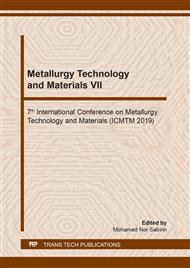[1]
W. Yan, H. C. Xu, W. Q. Chen, Study on inclusions in wire rod of tire cord steel by means of electrolysis of wire rod, J. Sci. Steel Research International. 85 (2014) 53-59.
DOI: 10.1002/srin.201300045
Google Scholar
[2]
L.Shi, J. Hong, X. M. Li, Control of titanium inclusions in tire cord steel, Research on Iron & Steel. 42 (2014) 50-52.
Google Scholar
[3]
H. Y. Liu, J. Q. Zheng, Y. H. Li, Investigation of Ti Inclusions in tire cord steel, Journal of University of Science and Technology Beijing. 32 (2010) 866-871.
Google Scholar
[4]
Y. D. Jiang, J. Zhang, Z. L. Xue, Genetic analysis for large TiN inclusions in wire rod for tire cord steel, J. Sci. Journal of Iron and Steel Research International. 21 (2014) 91-94.
DOI: 10.1016/s1006-706x(14)60128-x
Google Scholar
[5]
J. L. Lei, Z. L. Xue, Y. D. Jiang, Study on TiN precipitation during solidification of hypereutectoid tire cord steel, J. Sci. Metalurgia International. 17 (2012) 10-17.
Google Scholar
[6]
Q. Wang, Y. J. Lu, S. P. He, Confirmation of TiN and Ti(CN) in TiO2-containing mould fluxes at high temperature, The 9th national conference on continuous casting. (2011) 484-488.
Google Scholar
[7]
R. S. Dutta, R. Tewari, P. K. De, Effects of heat-treatment on the extent of chromium depletion and caustic corrosion resistance of alloy 690, J. Sci. Corrosion Science. 49 (2007) 303-318.
DOI: 10.1016/j.corsci.2006.05.043
Google Scholar
[8]
W. J. Ma, Y. P. Bao, L. H. Zhao, Control of the precipitation of TiN inclusions in gear steels, J. Sci. International Journal of Minerals Metallurgy & Materials. 21 (2014) 234-239.
DOI: 10.1007/s12613-014-0900-2
Google Scholar
[9]
W. Z. Mai, H. Yu, Effects of precipitates and inclusions on the fracture toughness of hot rolling X70 pipeline steel plates, J.Sci. International Journal of Minerals Metallurgy & Materials. 19 (2012) 805-811.
DOI: 10.1007/s12613-012-0632-0
Google Scholar
[10]
Q. L. Yong, J. G. Tian, W. Y. Yang, Physical metallurgical data of titanium in steels, Journal of Yunnan Polytechnic University. 15 (1999) 7-10.
Google Scholar
[11]
Y. Wang, L.Zeng, H. J. Miao, Research on nitride inclusion in electric slag remelting process of GH4700 superalloy for 700 °C ultra-supercritical boilers, Hot Working Technology. 41 (2012) 31-33.
Google Scholar
[12]
H. Y. Liu, H. L. Wang, L. Li, Investigation of Ti inclusions in wire cord steel, J. Sci. Ironmaking & Steelmaking. 38 (2011) 53-58.
DOI: 10.1179/030192310x12706364542588
Google Scholar


